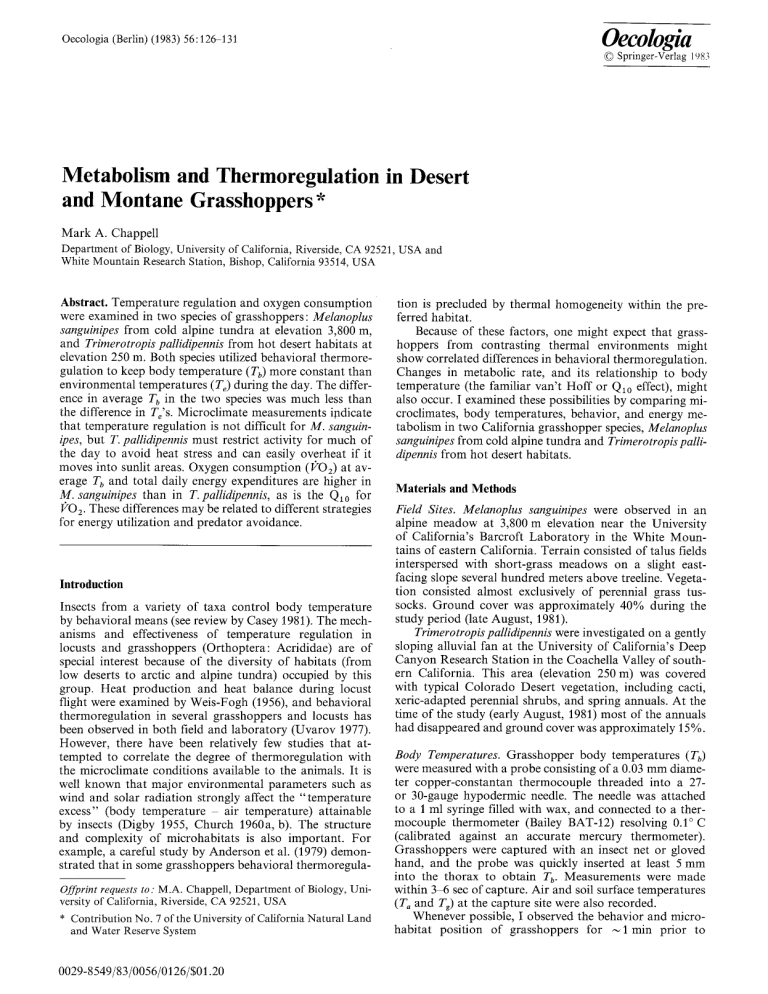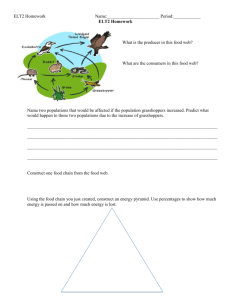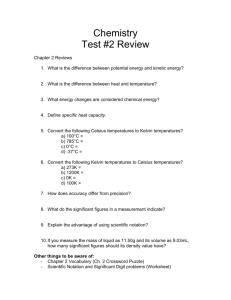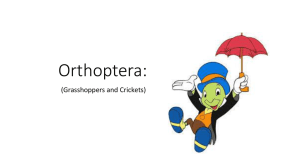Metabolism and thermoregulation in desert and montane
advertisement

Oecologia
9 Springer-Verlag 1983
Oecologia (Berlin) (1983) 56:126-131
Metabolism and Thermoregulation in Desert
and Montane Grasshoppers*
Mark A. Chappell
Department of Biology, University of California, Riverside, CA 92521, USA and
White Mountain Research Station, Bishop, California 93514, USA
Abstract. Temperature regulation and oxygen consumption
were examined in two species of grasshoppers: Melanoplus
sanguinipes from cold alpine tundra at elevation 3,800 m,
and Trimerotropis pallidipennis from hot desert habitats at
elevation 250 m. Both species utilized behavioral thermoregulation to keep body temperature (Tb) more constant than
environmental temperatures (T~) during the day. The difference in average Tb in the two species was much less than
the difference in Te's. Microclimate measurements iladicate
that temperature regulation is not difficult for M. sanguinipes, but T. pallidipennis must restrict activity for much of
the day to avoid heat stress and can easily overheat if it
moves into sunlit areas. Oxygen consumption (/202) at average Tb and total daily energy expenditures are higher in
M. sanguinipes than in T. pallidipennis, as is the Qlo for
ITOz. These differences may be related to different strategies
for energy utilization and predator avoidance.
Introduction
Insects from a variety of taxa control body temperature
by behavioral means (see review by Casey 1981). The mechanisms and effectiveness of temperature regulation in
locusts and grasshoppers (Orthoptera: Acrididae) are of
special interest because of the diversity of habitats (from
low deserts to arctic and alpine tundra) occupied by this
group. Heat production and heat balance during locust
flight were examined by Weis-Fogh (1956), and behavioral
thermoregulation in several grasshoppers and locusts has
been observed in both field and laboratory (Uvarov 1977).
However, there have been relatively few studies that attempted to correlate the degree of thermoregulation with
the microclimate conditions available to the animals. It is
well known that major environmental parameters such as
wind and solar radiation strongly affect the "temperature
excess" (body temperature
air temperature) attainable
by insects (Digby 1955, Church 1960a, b). The structure
and complexity of microhabitats is also important. For
example, a careful study by Anderson et al. (1979) demonstrated that in some grasshoppers behavioral thermoregula-
Offprint requests to: M.A. Chappell, Department of Biology, University of California, Riverside, CA 92521, USA
* Contribution No. 7 of the University of California Natural Land
and Water Reserve System
0029-8549/83/0056/0126/$01.20
tion is precluded by thermal homogeneity within the preferred habitat.
Because of these factors, one might expect that grasshoppers from contrasting thermal environments might
show correlated differences in behavioral thermoregulation.
Changes in metabolic rate, and its relationship to body
temperature (the familiar van't Hoff or Qio effect), might
also occur. I examined these possibilities by comparing microclimates, body temperatures, behavior, and energy metabolism in two California grasshopper species, Melanoplus
sanguinipes from cold alpine tundra and Trimerotropis pall#
dipennis from hot desert habitats.
Materials and Methods
Field Sites. Melanoplus sanguinipes were observed in an
alpine meadow at 3,800 m elevation near the University
of California's Barcroft Laboratory in the White Mountains of eastern California. Terrain consisted of talus fields
interspersed with short-grass meadows on a slight eastfacing slope several hundred meters above treeline. Vegetation consisted almost exclusively of perennial grass tussocks. Ground cover was approximately 40% during the
study period (late August, 1981).
Trimerotropis pallidipennis were investigated on a gently
sloping alluvial fan at the University of California's Deep
Canyon Research Station in the Coachella Valley of southern California. This area (elevation 250 m) was covered
with typical Colorado Desert vegetation, including cacti,
xeric-adapted perennial shrubs, and spring annuals. At the
time of the study (early August, 1981) most of the annuals
had disappeared and ground cover was approximately 15 %.
Body Temperatures. Grasshopper body temperatures (Tb)
were measured with a probe consisting of a 0.03 mm diameter copper-constantan thermocouple threaded into a 27or 30-gauge hypodermic needle. The needle was attached
to a 1 ml syringe filled with wax, and connected to a thermocouple thermometer (Bailey BAT-12) resolving 0.1~
(calibrated against an accurate mercury thermometer).
Grasshoppers were captured with an insect net or gloved
hand, and the probe was quickly inserted at least 5 mm
into the thorax to obtain Tb. Measurements were made
within 3 6 sec of capture. Air and soil surface temperatures
(Ta and Tg) at the capture site were also recorded.
Whenever possible, I observed the behavior and microhabitat position of grasshoppers for ~1 min prior to
127
capture. However, in many cases I did not notice the animals until they were frightened into escape behavior
(leaping or short flights). When this happened I immediately captured the insects (usually within 10 15 sec), obtained
Tb, and measured Ta and Tg at the site where the animals
had been resting.
Oxygen consumption. I measured the energy metabolism of
grasshoppers as oxygen consumption (r
at several ambient temperatures. Metabolism chambers consisted of
60 ml plastic syringes equipped with 2-way stopcock valves.
Animals were placed individually into syringes (with open
valves) and allowed to adjust to the experimental temperature for 40-60 min. To begin a measurement, the metabolism syringes (along with one or two syringes of reference
air) were flushed with ambient air by 10-15 cycles of rapid
filling and emptying to 75 80% of capacity (without crushing the grasshoppers). Assuming complete mixing in the
syringes, the proportion of residual air was approximately
] 0 - 6 . Stopcock valves were then closed, and the syringes
were held for 15-65 min at the desired temperature. At the
end of metabolism runs, sample and reference gases were
injected at constant pressure and flowrate through dessicant
(Dryerite) into an Applied Electrochemistry S-3A oxygen
analyzer. The ~,)0 2 w a s calculated by multiplying the volume of the syringe by the change in oxygen concentration
and dividing by the run time, after converting volume to
STPD. Atmospheric pressure was obtained from a mercury
barometer. The respiratory quotient (RQ) was assumed to
be 1.0, since the animals fed primarily on carbohydrates
and were not starved prior to the experiments (r
measurements were always made within 4 h of capture). In no
case did oxygen concentration fall below 19.8% during a
run.
Following ~'O 2 determinations, T. pallidipennis were
killed with ethyl acetate vapor and weighed to the nearest
milligram (mg) on a Sartorius balance. No balance was
available at the Barcroft field station, so M. sanguinipes
were killed, dried, and later weighed to the nearest 0.1 mg
on a Mettler balance in my laboratory at the University
of California, Riverside. Dry mass was converted to wet
mass by dividing by 0.34. This factor (range 0.31-0.40) was
determined by comparing wet to dry mass in 15 M. sanguinipes transported alive to Riverside.
Microclimate Data. I utilized the operative environmental
temperature (Te, Bakken 1976) as the principal thermal
index in grasshopper microhabitats. The Te is the equilibrium temperature which a metabolically inert body with the
size, shape, color, and surface characteristics of the animal
in question will attain in Specified conditions of T~, wind
speed (V), and solar radiation. Body temperatures of nonflying grasshoppers closely approximate Te, since metabolic
heat production and evaporative heat loss are very small
compared to heat exchange by conduction, convection, and
radiation (Anderson et al. 1979).
Field measurements of T e were made using dried grasshoppers equipped with 40-gauge thermocouples and placed
in normal postures in natural microhabitats. Dried grasshoppers have the same size, shape, and color as live animals
and hence react similarly to T,, V, and radiation (Bakken
1976). Two to three such 'Te thermometers' were placed
in each microhabitat of interest; a 40-gauge thermocouple
within 2-4 cm of each dried grasshopper measured T~.
Wind speed was determined with hot-bead anemometers
placed within 15 cm of dried grasshoppers. Anemometers
consisted of pairs of polished aluminum spheres 13 mm in
diameter, one of which was heated a known amount
through an embedded electrical resistor. The resulting temperature difference was inversely proportional to wind
speed (Chappell and Bartholomew 1981). Solar radiation
was measured with a LiCor LI-185 radiometer and LI-200S
sensor. Microclimate variables were recorded continuously
on a 24-channel multipoint recorder or every 15 rain on
a microprocessor-based datalogger system.
Results
Activity and Behavior. Both Melanoplus sanguinipes from
Barcroft and Trimerotropispallidipennis from Deep Canyon
were active primarily during the day. Only a few individuals
were captured before sunrise or after sunset, despite considerable searching. Within h after sunrise, however, grasshoppers could be found in large numbers (M. sanguinipes in
particular was extremely abundant). In early to mid-morning, both species frequented open, sunlit areas. By
09.00-10.00 h, most of the T. pallidipennis had moved from
bare ground and were located in the shade under shrubs
or occasionally in patches of grass. In contrast, M. sangumipes remained in exposed areas throughout the day.
Behavioral responses to environmental temperature by
grasshoppers include several well-defined postures (Waloff
1963, Anderson et al. 1979). Typically, if grasshoppers are
exposed to strong sunlight, the extention of the legs increases as temperatures increase, such that cold animals
crouch with bodies held against the substrate (if it is warm),
while hot animals 'stilt' with the body held as high above
the substrate as possible. Both M. sanguinipes and T. pallidipennis used the full range of these postures when artificially heated or shaded. However, when observed in the
field, M. sanguinipes were mostly found in a crouched posture, except in the midafternoon on hot days. In contrast,
T. pallidipennis were usually stilted, except in the early
morning when air and ground temperatures were low.
For most of the day, I saw little evidence of orientation
with respect to the sun's position in either species (except
for shade-seeking in hot conditions). Some basking behavior was observed for M. sanguinipes early in the morning.
The animals would sit quietly in the sun with their long
axis perpendicular to the solar beam. When shaded from
direct sunlight and illuminated with sunlight reflected from
a mirror, they would reorient to the reflected beam, ~ tracking" it as it was moved about. Most basking behavior
ceased within an hour or two after sunrise.
Body Temperatures. Insect body temperatures may change
rapidly during intense muscular activity, as occurs when
netted animals struggle to escape. To avoid this possibility
I measured Tb within a few seconds of capture. On several
occasions I obtained Tb immediatly after capture, allowed
the animal to struggle for 20-30 sec, and repeated the Tb
measurement. In no case did Tb change by more than 1~ C
between readings, and in 7 instances out of 12 the change
was less than 0.5 ~ C.
After the sun had risen, both M. sanguinipes and T. pal
lidipennis had Tb's hotter than the air temperature at the
capture site (Fig. 1), but temperature excess (Tb-T~) tended
to decrease as T~ increased. Slopes of the regressions of
128
.:
9
40
'
~"
30
-".'.
" "'i."
.~."
".~.~
20
9
500
BARCROFT
0
//
9
.::
I
o
~c~
:.
..,
9 I
eJ
/ / o--'
~
.:r
:"
I000
#
~176
.~
9 ::
V
I
I
i
i
/
[~"=-.".-i~jF'.::.]" :" ~"
~176 ,~.
10
.T. /
10
,
i
20
i
30
,
i
40
E
,
50
>
~
To
Fig. t. Relationship between body temperature (Tb) and air temperature at the site of capture (T,) in wild Trimerotropispallidipennis
(open circles) in Deep Canyon (elevation 250 m) and Melanoplus
sanguinipes (dark circles) at Barcroft (elevation 3,800 m). Dashed
and dotted line represents Tb = T,, solid line is regression of Tb
on T, for T. pallidipennis, and dashed line is the similar regression
for M. sanguinipes
Od
I000
.
OL
6
9
I II
ii
I
z,~
i,~
~,~
12
15
TIME
18
Fig. 3. Incident solar radiation (Qr, top) and wind speed (V~
bottom) at the Barcroft site. Wind speed measured 1 cm above
soil surface
//
",\
i
50
500
/
, ......."...:
9
\
/ ..........
~.......,;.
:" 9,"........
..~....,,.-\
/...:., "1 "~,. . . . . . . . . . .
-,--,--'::..t..
F
DEEPCANYON
I
0
I
I
I-
I
[
E
.os,
60 F
Ii!i
cY
~
I'i~t
~',,P-''-
F,~
9
>
!
~II
0[i
.
.
" ".'I;
i
o '
I
6
.
II
9
I
12
TIME
i,:.
.
i
* " ":
'
I
I
15
18
;"'
"
6
"
l~ pallidi,nnis, Deep C.....
I
i
8
~
t
I0
I
i
I
12
TIME
i
14
i
t
16
i
18
Fig. 4. Environmental (T~) and body temperatures for Trimerotropis pallidipennis at Deep Canyon. Solid line: Te for grasshopper
in deep shade under large, dense shrubs. Short dashes: Te for grasshoppers in the shade of Encelia and Larrea shrubs. Dotted line:
Fig. 2. Incident solar radiation (Qr, top) and wind speed (V,
bottom) at the Deep Canyon site. Wind speed measured I cm
above soil surface
Te for grasshoppers in "stilted" posture in open areas. Long
dashes: Te for grasshoppers in crouched posture in open areas.
Dots represent body temperatures of free-living grasshoppers
Tb on T a were significantly different from 0 and 1 for both
species. However, the slope for T. pallidipennis (0.75, r 2 =
0.76/, N = 77) was significantly greater ( P < 0 . 0 1 ) than the
slope for M. sanguinipes (0.54, r 2 = 0.408, N = 200), indicating that T b is more highly dependent on Ta in T. pallidipennis. Temperature excess in M. sanguinipes was usually much
larger than for T. pallidipennis (about 15 ~ C as opposed to
5 ~ C), and the range of Tb's in M. sanguinipes (32.7 ~ C) was
considerably greater than observed for T. pallidipennis
(19.6 ~ C). Nevertheless, the average Tb's of the two grasshoppers were fairly similar (35.3 ~ C for M. sanguinipes and
43.0~ C for T. pallidipennis; N = 2 0 0 and 77 respectively),
despite large differences in environmental conditions. The
maximum Tb observed for M. sanguinipes, 43.4 ~ C, was
only 5.9 ~ C cooler than the maximum of 49.3 for T. pallidi-
higher at Barcroft, presumably because of the more transparent atmosphere at high altitudes, and wind speed at
grasshopper height (1 cm) was lower at Barcroft. Nevertheless, air, ground, and grasshopper environmental temperatures (Te) were 15-20 ~ C hotter throughout the day at Deep
Canyon than at Barcroft. Figures 4 and 5 show grasshopper
T e in some of the microhabitats used by the animals,
ranging from the coldest (shade) to the hottest available
(on the soil surface in full sunlight). The body temperatures
of field-caught grasshoppers are also shown.
pennis.
Microclimates. During the study periods, the weather at
both field sites consisted of clear, sunny days with moderate
winds (Figs. 2 and 3). Solar radiation intensity was 10-15%
Metabolism. Energy metabolism measured as oxygen consumption increased as T, increased for both Melanopus sanguinipes and Trimerotropis pallidipennis. Body temperature
was not measured during these experiments, but in no case
was metabolic heat production large enough to generate
a temperature gradient of more than 0.3~ between Tb
and T, (calculated from unpublished data on thermal conductance). I therefore assumed Tb was equal to T,. The
I702 was expressed in units of watts/g or cc O2/g'h to facili-
129
-1.5
12
/
/
401-
l
A
/
..
{
,
~I
". .,~ $
""~
"b
12
~,
.',
9
.~'
\
,..
9
.,'.lr~..
"................... " ;te,
"
\
S " " " ........ ~
)
'
/
,
'
M sanguinipes,
I0 .i'
&
"
-1.5
-2
0
5o L
/ "/'~ . . . .....................
. . . . . . . .
~1762 0 t
\
>
~,5
;+
c9 -2.5
o
"
Barcroft
8
I0
12
14
TIME
16
18
-2
12
6
12
7
M sanguinipes
1.5
12
2
T. paliidipennis
-5
I
2O
i
L
50
Ta ~
i
i
40
I
5O
Fig. 7. Oxygen consumption as a function of temperature in Melanoplus sanguinipes. Symbols as in Fig. 6
10
-2.5
20
I
slopes significantly greater (P<0.01) than the slope of the
similar regression for T. pallidipennis. The Qlo value for
M. sanguinipes is 2.67 at Ta between 12 and 35 ~ C, dropping
to 2.23 if all data points are included.
22
12
I
I0
Fig. 5. Environmental and body temperatures for Melanoplus sanguinipes at Barcroft. Symbols as in Fig. 4 except that solid line
represents Te in shade of grass tussocks
c9
o
J
-2
to
3
-25
-5
05
o>
o
12
I
50
I
I
40
TQ ~
to
3
2.5
I
I
50
Fig. 6. Oxygen consumption (1702) as a function of temperature
(T,) in Trimerotropispallidipennis. Vertical line is range, horizontal
line is mean, and bar is 2 standard errors on either side of the
mean
rate interspecific comparisons, although mean body masses
were similar (328 mg for T. pallidipennis and 295 mg for
M. sanguinipes).
A plot of log V O 2 against Ta is approximately linear
for both species (Figs. 6 and 7). For T. pallidipennis, the
data are adequately described by the regression log 1/O2
(watts/g)=O.O234(Ta)-3.15 (r1=0.69, N=108). The low
r 2 value is due mainly to the high variability at T~ = 23.5 ~ C
(Fig. 6). Nevertheless, the slope is significantly different
from zero (P<0.05). The Qlo for VO 2 is 1.72 in T. pallidipennis, or about 70% of the " n o r m a l " value of 2.5. Some
leveling off of the Q 1o curve occurred at temperatures above
38 ~ C, but the slope of the regression o f VO 2 o n T a for
T~ below 37~ (Qao=1.89) is not significantly different
from the slope for Ta of 38 ~ C and above (Qxo = 1.40).
The fit of the 1202 data to a straight line is very close
for M. sanguinipes at T, between 12 and 35 ~ C: log 1/O2=
0.0426(T,)--3.389 @2=0.915, N=48), At 7,=42.5 ~ C (the
highest temperature used for this species), ~202 appears to
be slightly depressed (Fig. 7). If the 42.5 ~ C data are included, the regression becomes log 1202=0.0348(T,)3.238 @2=0.90, N=60). Both of these regressions have
Discussion
Temperature Regulation and Microclimates. Examination of
Fig. 1 suggests that Trimerotropis pallidipennis from Deep
Canyon are less effective thermoregulators than are Melanoplus sanguinipes from Barcroft. The slope of the regression
of Tb on T, is significantly higher in T. pallidipennis, indicating that T b is more highly dependent on T, in this species.
T. pallidipennis Tb's are within about 5 7~ C of T, throughout the day, while M. sanguinipes maintain a "temperature
excess" of ~15 ~ C. However, both grasshoppers show
postural responses appropriate for behavioral thermoregulation (Waloff 1963, Anderson et al. 1979) when subjected
to hot and cold conditions in the laboratory, and both environments offer enough heterogeneity so that the animals
can select from a variety of thermal regimes. Also, the Tb's
of wild-caught 7". pallidipennis average only 7.7~ higher
than those of M. sanguinipes, despite microclimate temperatures at least 20 ~ C higher in Deep Canyon than at Barcroft.
Both T. pallidipennis and M. sanguinipes succeed in
maintaining T b more constant than environmental temperatures throughout the day, but the major thermoregulatory
" p r o b l e m s " of the two species are quite different. At the
high-altitude Barcroft size, T a and Tg drop to 0 ~ C or below
at night, and even after the sun rises near-ground Ta increases slowly to a maximum of about 25-30 ~ C. Thus the
principal thermoregulatory challenge for M. sanguinipes is
to keep Tb high in the face of low T,. The animals accomplish this task by maximizing exposure to solar radiation
through early morning basking behavior, and by avoiding
shaded areas throughout the remainder of the day. The
necessity of utilizing open habitats is indicated by the data
in Fig. 5. Almost all M. sanguinipes T b measurements
throughout the day fell between the Te's for animals
crouched against the soil surface (the hottest microclimate),
or 'stilted' to an height of 1 cm above the soil in sunlight.
Several Tb's in the early morning were higher than the soil
130
surface temperatures I measured, probably indicating that
the animals were better at finding the warmest microenvironments than I was. In contrast, shade Te'S during the
day were cooler than Tb by at least 10 ~ C (by up to 20 ~ C
in the morning). Thus, in order to maintain a high and
relatively constant Tb, M. sanguinipes need simply remain
in sunlit areas and adjust its degree of stilting above the
substrate. Overheating is essentially impossible for this
species. Although ground temperatures occasionally exceed
50 ~ C, the T e for 'stilted' grasshoppers is always 10~15 ~ C
cooler (well within the observed Tb range). All animals observed on bare ground at midday were stilted. When foraging in grass clumps, M. sanguinipes showed very little behavior that was obviously thermally related, except to move
into the sunlight if they were artificially shaded.
Unlike M. sanguinipes, T. pallidipennis must continually
strive to keep Tb as low as possible. Except for a short
period after sunrise, thermal conditions for grasshoppers
in open areas are intolerably hot in Deep Canyon. The
upper limit of Tb for this species is about 52 ~ C; some locomotory dysfunction begins at Tb's above 50~ and the
grasshoppers attempt to avoid temperatures above
46-47 ~ C (unpublished observations). Ground temperatures
exceed 50 ~ C by 09.00-10.00 and attain levels of 60-70 ~ C
for several hours, with Te's for stilted animals remaining
between 45 and 50 ~ C for most of the day. In general, thermally acceptable conditions for T. pallidipennis dependably
occur only in shaded microhabitats (Fig. 4). As might be
expected, after about 09.00 most individuals were found
on the ground under Larrea or Encelia plants; occasionally
they ascended a few cm into the branches. The steeper slope
of the Tb-T ~ regression in T. pallidipennis probably reflects
the lack of cool refugia in its desert habitat. At high Ta
the animals have moved into the coolest available microclimate and have no further ability to reduce Tb; hence, Tb
will closely track shade To.
Field observations revealed that T. pallidipennis spent
much more of their time engaged in thermoregulatory behavior than did M. sanguinipes, despite the greater independence of Tb from Ta in the latter species. When resting
during the hot parts of the day, T. pallidipennis positioned
themselves in the small patches of shade cast by leaves or
branches, continually "tracking" them as the sun moved.
Unless the animals were disturbed, little or no additional
activity was noted. This observation contrasts somewhat
with that of Anderson et al. (1979), who found that greater
development of thermoregulatory behavior was associated
with greater independence of Tb from T, in two species
of grasshoppers from Colorado grasslands.
Despite the shade-seeking behavior of T. pallidipennis,
average Tb during the day was 43 ~ C and several individuals
had Tb's within 1 or 2 ~ C of the upper limit of 50 ~ C (Tb
exceeded T, under shrubs because shade was usually partial
and soil temperatures were normally 5-10~ C above Ta).
These high Tb's may limit the duration and effectiveness
of escape behavior. Frightened T. palh'dipennis typically fly
for short distances (3-10 m), land, and freeze into immobility in a crouched posture. Flights usually terminate on
bare, shadeless ground. A grasshopper with a Tb of
43 44~ which lands on 65~ soil can sit for less than
a minute before Tb approaches 50 ~ C (unpublished observations). At this point the animal must move into the shade
(thereby giving away its position), or risk death from hyperthermia.
Metabolism. The oxygen consumption of both Melanoplus
sanguinipes and Trimerotropis pallidipennis at body temperatures of 20~ is within the range of 1)O2 measured in
other resting insects (Batholomew 1981). However, The Qlo
for 1)O 2 in T. pallidipennis (1.72) is significantly lower than
that of M. sanguinipes (2.23), and is also substantially less
than the normal value of 2-2.5 (Bartholomew 1977). The
observed Qlo'S are probably realistic for free-living grasshoppers, since all VO 2 measurements for T. pallidipennis
and M. sanguinipes were made at temperatures regularly
experienced by the animals in the field.
Differences in Qlo are reflected in absolute rates of energy metabolism. At the average daytime Tb's experienced
by the two species, 1)O2 is about 50% higher in M. sanguinipes than in T. pallidipennis (42 J/h vs 28.5 J/h respectively).
If Q~o-determined 1)O2 is integrated over average Tb during
a typical day, total daily metabolic expenditures for M. sanguinipes ( ~ 550 J) are 27% higher than for T. pallidipennis
( ~ 435 J). The temporal patterns of energy expenditure are
also different. M. sanguinipes spends only 9% of its daily
energy budget during the 12 h of night and approximately
*/z-1 h of morning warm-up and evening cool-down. Low
nocturnal metabolism results from low temperatures
(0-5 ~ C) at night and M. sanguinipes's high Qlo- In contrast, T. pallidipennis has a low Qlo and experiences
nighttime temperatures of 20 25 ~ C. Consequently, this
species spends about 35% of its daily energy budget
during the night, morning warm-up, and evening cooldown.
Ecological considerations may help explain the differences in metabolic rate and Qlo in the two grasshoppers.
At the high-altitude Barcroft site, the snow-free activity
season for grasshoppers lasts only 3 4 months, but during
this period food supplies are relatively abundant. Consequently, M. sanguinipes should benefit from rapid growth
and energy accumulation, with concomitant high metabolic
rates. A high Q~o and low nocturnal temperatures allow
M. sanguinipes to conserve energy by reducing metabolic
expenditures to very low levels at night.
In Deep Danyon, the activity season is long but food
is scarce after the crop of spring annuals has disappeared,
and high environmental temperatures preclude diurnal activity in much of the habitat. Hence, T. pallidipennis probably experience selection for an overall reduction in energy
metabolism. The low Qlo in this species may be related
to predator avoidance. Body temperatures of T. pallidipennis are about 20-25 ~ C cooler at night than during the day.
However, the animals are still alert and responsive at typical
night-time Tb's, and are capable of effective escape responses. This ability may be important, because nocturnally-active grasshopper predators are abundant and
diverse in Deep Canyon (including rodents, snakes, lizards,
toads, scorpions, and other arthropods). If the Q~o of
T. pallidipennis was as high as that of M. sanguinipes, the
nocturnal metabolic rate of T. pallidipennis would be 3.2
times lower than observed (assuming 1)O2 at the average
diurnal Tb is the same). Such a reduction in metabolism
might be reflected in a reduced ability to avoid predators.
For example, M. sanguinipes cooled to typical nighttime
Tb'S (also about 25 ~ C below daytime values) are unresponsive and almost immobile. Predator pressure is probably
considerably lower at Barcroft than in Deep Canyon, since
the only potential nocturnal predators of M. sanguinipes
are deer mice.
131
Acknowledgements. Use of the facilities of the University of California's White Mountain Research Station (Barcroft Laboratory) and
Boyd Deep Canyon Desert Research Station were vital to this
project. Saul Frommer of the UCR Department of Entomology
was of great assistance in identifying specimens. Funds provided
by a UCR Intramural grant and the White Mountain Research
Station.
References
Anderson RV, Tracy CR, Abramsky Z (1979) Habitat selection
in two species of short-horned grasshoppers. Oecologia
38 : 359-374
Bakken GS (1976) A heat transfer analysis of animals: Unifying
concepts and the application of metabolism chamber data to
field ecology. J Theoret Biol 60:337-384
Bartholomew GA (1977) Body temperature and energy metabolism. In: Gordon MS (ed), Animal Physiology, Principles and
Adaptations. MacMillan, New York, pp 364-449
Bartholomew GA (1981) A matter of size: An examination of
endothermy in insects and terrestrial vertebrates. In: Heinrich
B (ed), Insect Thermoregulation. John Wiley and Sons, New
York, pp 45 78
Casey TM (1981) Behavioral mechanisms of thermoregulation. In:
Heinrich B (ed), Insect Thermoregulation. John Wiley and
Sons, New York, pp 79-114
Chappell MA, Bartholomew GA (1981) Standard operative temperatures and thermal energetics of the antelopeground squirrel
Ammospermophilus leucurus. Physiol Zool 54:81-93
Church NS (1960a) Heat loss and the body temperature of flying
insects. I. Heat loss by evaporation of water from the body.
J Exp Biol 37:17:1-185
Church NS (1960b) Heat loss and the body temperature of flying
insects. II. Heat conduction within the body and its loss by
radiation and convection. J Exp Biol 37:186-213
Digby PSB (1955) Factors affecting the temperature excess of
insects in sunshine. J Exp Biol 32:279-298
Uvarov B (1977) Grasshoppers and Locusts, A Handbook of General Acridology, vol. 2. Centre for Overseas Pest Research,
London
Waloff Z (1963) Field studies on solitary and transient desert
locusts in the Red Sea area. Anti-Locust Bull 40:1-93
Weis-Fogh T (1956) Biology and physics of locust flight. II. Flight
performance of the desert locust (Schistocerea gregaria). Phil
Trans R Soc Lond B 239:459-510
Received February 18, 1982






